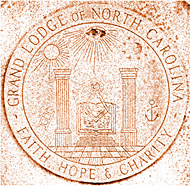|
The Naming of the "Sun, Moon and Stars" Tony Marsh, June 2010 As explained on the webpage dedicated to the Sun, Moon and Stars Inn, there was a name change in Victorian times when the old name - Half Moon Inn - was dropped (but not quite abandoned completely for many decades). We have Dan Weinbren's new book "The Oddfellows 1810 - 2010" published in the Spring of 2010 to thank for new light shed on this topic. Dan Weinbren has kindly presented us with a complimentary copy of the book which will be held by the Blisworth Heritage Society.
The sun, moon and stars, known in Scripture as the host of heaven, are found to the fore in Masonic imagery (see http://www.secretsofmasons.com/masonic-symbols.htm from which the imagery in the inset photo was obtained) and have been relevant symbols in Baal worship, in the occult and, perhaps with less thought behind them, in various "new age" shops. For the Oddfellows the "sun, moon and stars" collectively might represent all God's creation, all that is wonderful and admirable. Individually the sun and moon would represent opposites and to bring them together in a ceremony would avow to desire a unity within society, co-operation and harmony. The stars, in particular the seven stars (and the inn was indeed once named with the seven), recalls The Plaides constellation representing the "seven liberal arts". Including this seven stars symbol avows to strive to a better education, bearing in mind that many members of the Oddfellows were of modest background. The seven liberal arts, as defined classically, are Poetry, Thinking carefully and logically, Speaking clearly and/or persuasively, Arithmetic, Geometry, Music and Astronomy. For a labourer, the last four would translate perhaps to Numeracy and an appreciation of Art. These educational targets have cropped up frequently, for example: Pius XII said (September 5, 1957): "A liberal arts education remains unequalled for the exercise and development of the most valuable qualities of the mind: penetration of thought, broadmindedness, fineness of analysis, gifts of expression. Not all students will be able to reach all seven. Maybe not even all our teachers . . . the approach to every new subject should be, however, an open door." The Oddfellows also was a friendly society, that is a form of mutual insurance association that was far more financially robust than the church and Duke of Grafton's charities on account of nationwide subscriptions. Men subscribed a small sum each month into a common pot, often at a ‘lodge’ meeting in a pub. Members could expect payments from the common funds in the event of illness or death. There were social and ritual elements to meetings, referred to above as 'ceremony', and these would have reinforced the sense of occasion and importance. Through ceremony the Oddfellows avowed to betterment both in themselves as individuals and in how they volunteer to help neighbours. Imagery common to Oddfellows and to Freemasonry can be found in Weinbren's book on pages 219 and 221 and in frequent internet references, particularly to Freemasonry. The Half Moon Inn was registered as a lodge for the Oddfellows in 1842. We have just one reference that the "host of heaven" naming for the inn occurred briefly in 1822 but was not adopted generally (Mr. Rivett, c1966, referring to the conveyancing to P. Phipps - deeds have not been re-checked yet). If this were true it would suggest that a band of village men met there around that time and had formed at least a pseudo-Masonic group which must have found best expression later in terms of Oddfellowship, in 1842. From then on there would be suppertime conversations in which the wife might say, for example: "you'll do the ... if there's time after all the 'sun moon and stars' has finished?" to which the reply might be: "Na, it's sun moon and stars on Wednesdays not Thursdays - it's Royal Oak tonight!" - hence the name change. Records for the Wellingborough Lodge indicate that in 1930s it was moved that ritual and ceremony would be dropped as its continuance was having an adverse effect on the numbers wishing to join. Please refer to the article dealing with membership statistics and founder members for a little more on the early years.
|

 The inset here is a copy of the logo used
by the Blisworth Historical Buildings Trust which was formed, 2007 to
2010, to promote a community use for the inn building. The
building had been
compulsorily purchased by the South Northamptonshire Council but will apparently
be disposed of on the open market as the council
experienced difficulties in achieving a viable plan for its
restoration. However, the Oddfellows heritage of the building
should not be lost to posterity and it is hoped that the logo, with the
encircling words changed to recall the 1842 registration of the inn, be re-created in
durably-enamelled
stainless steel and affixed to
the front of the building.
The inset here is a copy of the logo used
by the Blisworth Historical Buildings Trust which was formed, 2007 to
2010, to promote a community use for the inn building. The
building had been
compulsorily purchased by the South Northamptonshire Council but will apparently
be disposed of on the open market as the council
experienced difficulties in achieving a viable plan for its
restoration. However, the Oddfellows heritage of the building
should not be lost to posterity and it is hoped that the logo, with the
encircling words changed to recall the 1842 registration of the inn, be re-created in
durably-enamelled
stainless steel and affixed to
the front of the building.